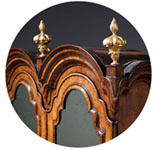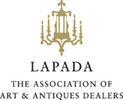17th century William and Mary Ebony Eight-Day table clock by James Markwick
Sold
Price Enquiry
Follow Us
17th century William and Mary Ebony Eight-Day table clock by James Markwick
The elegantly proportioned ebony-veneered basket top case has fine cast brass ornaments to the door and rectangular windows to the sides so that the exquisite movement is almost entirely visible. The case rests on four fire-gilt brass bun feet.
The fine square brass dial with matted centre and ringed winding holes has an applied silvered chapter-ring, a date aperture above the VI, a false pendulum aperture under the XII and gilded winged cherub-head spandrels in the corners. The chapter ring is engraved with a narrow outer minute ring within Arabic five-minute numerals and 7½-minute markers, a central ring of Roman hours I-XII and half-hour markers and an inner ring divided into quarter hours. The elegant blued steel hands are finely pierced. The dial is signed on a silvered plaque behind the false pendulum, Markwick Londini.
The striking eight-day twin fusee brass movement, of which one of the five pillars is latched, has early fusees with open click work and unusual steel securing caps, and verge escapement with a short knife-suspended pendulum. The striking, which is regulated by an internal rack, indicates the hours fully on a bell. The backplate is profusely engraved in period style around a typical signature cartouche with the maker’s name: Markwick Londini. The movement has pull-quarter repeat on six bells differing in pitch.
The maker
James Markwick (c.1662-1716) was apprenticed to Edmund Gilpin in 1656. He married his master’s daughter around 1660. He is recorded to be active as a clockmaker in Croydon between 1661 and 1664. He was free of the Clockmakers’ Company in 1666. After this date, he lived in Coleman Street in London. In 1673 he succeeded to the property of the well-known clockmaker Samuel Betts. He had several apprentices over the years, among them his son James. Several longcases, as well as watches of his, are known, but spring-driven table clocks are rare. His son James followed in his footsteps, who later joined up with Robert Markham to form the renowned business Markham Markwick.
It should be noted that this is a sensational clock by a great maker and in the most wonderful condition throughout.
Condition
Good. Wear consistent with age and use.
Dimensions
Height: 15.5 in. (39.37 cm)
Width: 10.25 in. (26.04 cm)
Depth: 6.5 in. (16.51 cm)
Literature
B. Loomes, The Clockmakers of Great Britain 1286-1700, Ashbourne, 2014, pp.488-89.
B. Loomes, The Early Clockmakers of Great Britain, Tiptree, 1981
PREVIOUSLY SOLD
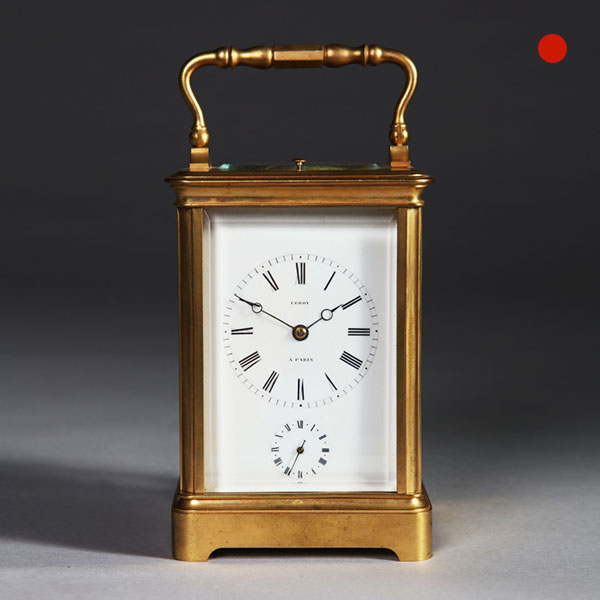
19th-Century Quarter-striking Carriage Clock by Leroy, Paris
The gilt-brass, so-called corniche case has bevelled glass panels on all sides so that the movement is entirely visible. It is surmounted by a shaped carrying handle. The white enamel dial has a Roman chapter ring, with Arabic five-minute and minute divisions.
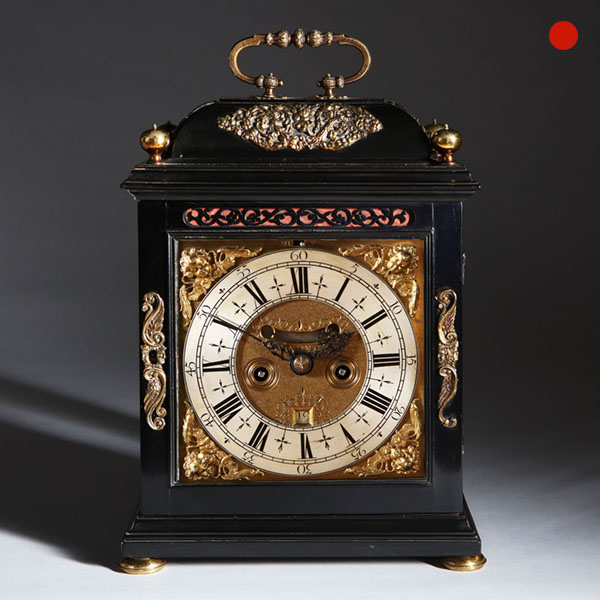
William and Mary Ebony Veneered Bracket Clock by Johnathan Lowndes
The ebony-veneered case has a so-called domed top, a design which became popular in the Charles II period (from 1675 onwards). The case is adorned with repousse brass ornaments and rests on gilt-brass bun feet. It is surmounted by a brass carrying handle of typical shape.
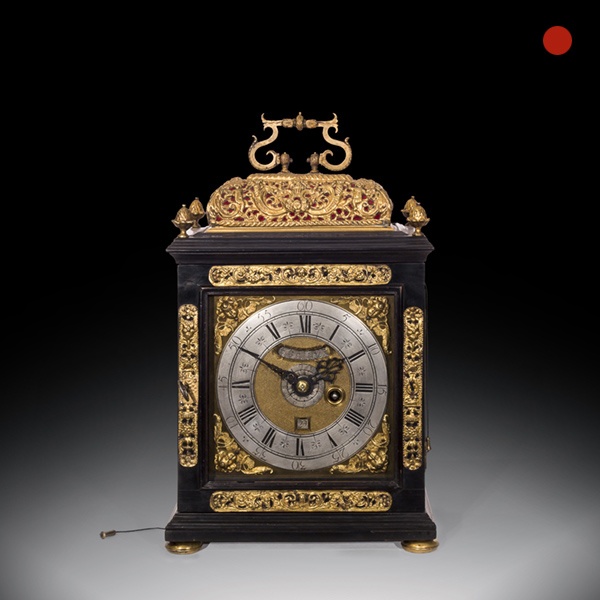
17th-Century Ebony Veneered Table Clock with Alarm and Pull Quarter Repeat
A magnificent sprung driven table clock by respected London maker George Etherington. The late 17th century, ebony- veneered table clock with alarm and pull quarter repeat on two bells, signed on the chapter ring Etherington London, and on the backplate Geo Etherington LONDON, c. 1695-1700.
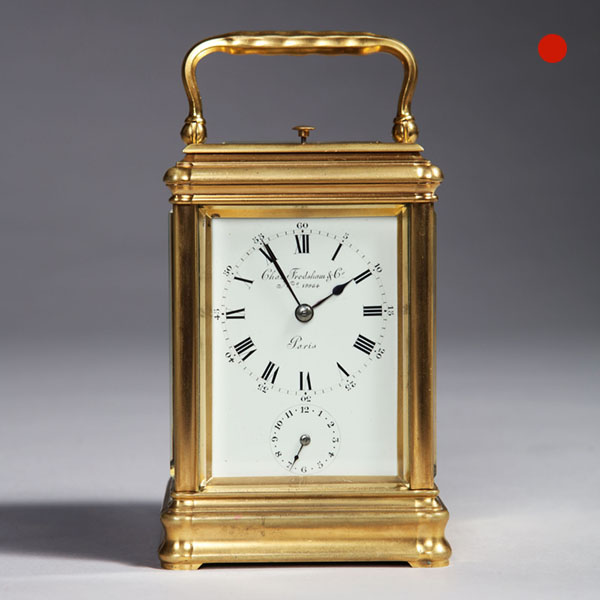
19th-Century Carriage Clock signed Charles Frodsham, London
The so-called gorge case has its original gilding. It has bevelled glass panels on all sides so that the movement is entirely visible and is surmounted by a shaped carrying handle. The white enamel dial has a Roman chapter ring, with Arabic five-minute and minute divisions.

19th-Century Quarter-striking Carriage Clock by Leroy, Paris
The gilt-brass, so-called corniche case has bevelled glass panels on all sides so that the movement is entirely visible. It is surmounted by a shaped carrying handle. The white enamel dial has a Roman chapter ring, with Arabic five-minute and minute divisions.

William and Mary Ebony Veneered Bracket Clock by Johnathan Lowndes
The ebony-veneered case has a so-called domed top, a design which became popular in the Charles II period (from 1675 onwards). The case is adorned with repousse brass ornaments and rests on gilt-brass bun feet. It is surmounted by a brass carrying handle of typical shape.

17th-Century Ebony Veneered Table Clock with Alarm and Pull Quarter Repeat
A magnificent sprung driven table clock by respected London maker George Etherington. The late 17th century, ebony- veneered table clock with alarm and pull quarter repeat on two bells, signed on the chapter ring Etherington London, and on the backplate Geo Etherington LONDON, c. 1695-1700.

19th-Century Carriage Clock signed Charles Frodsham, London
The so-called gorge case has its original gilding. It has bevelled glass panels on all sides so that the movement is entirely visible and is surmounted by a shaped carrying handle. The white enamel dial has a Roman chapter ring, with Arabic five-minute and minute divisions.
YOU MAY ALSO LIKE
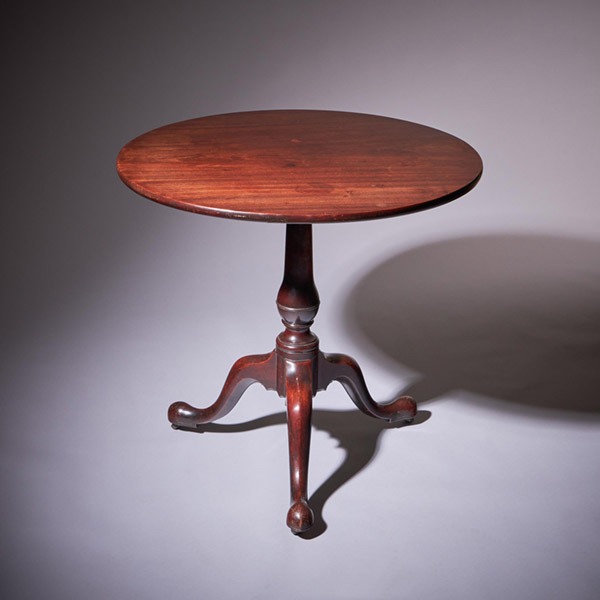
18th Century George III Mahogany Tripod Table, Circa 1770
18th Century George III Mahogany Tripod Table, Circa 1770 £2,200Follow Us18th Century George III...
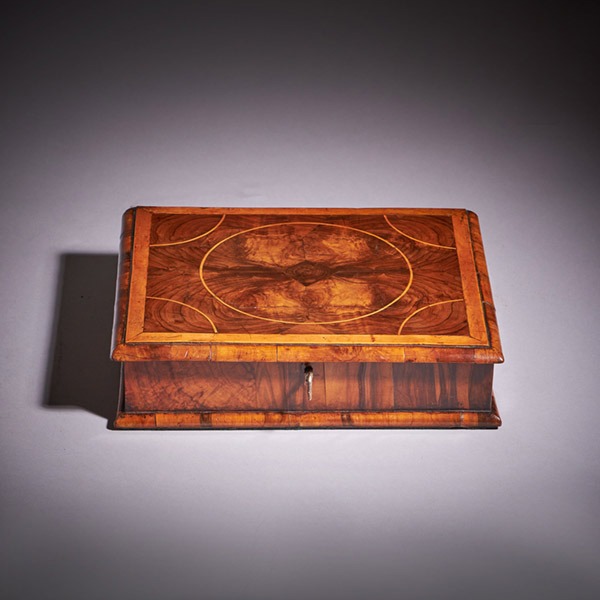
Fine William and Mary 17th Century Olive Oyster Lace Box
Fine William and Mary 17th Century Olive Oyster Lace Box £2,600Follow UsFine William and Mary 17th...
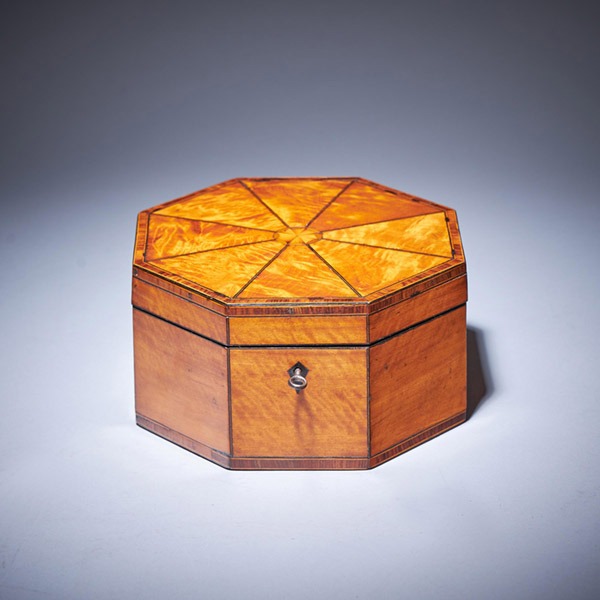
A Fine and Rare George III Octagonal Figured Satinwood Box, C.1790
A Fine and Rare George III Octagonal Figured Satinwood Box, C.1790 £2,200Follow UsA Fine and Rare...
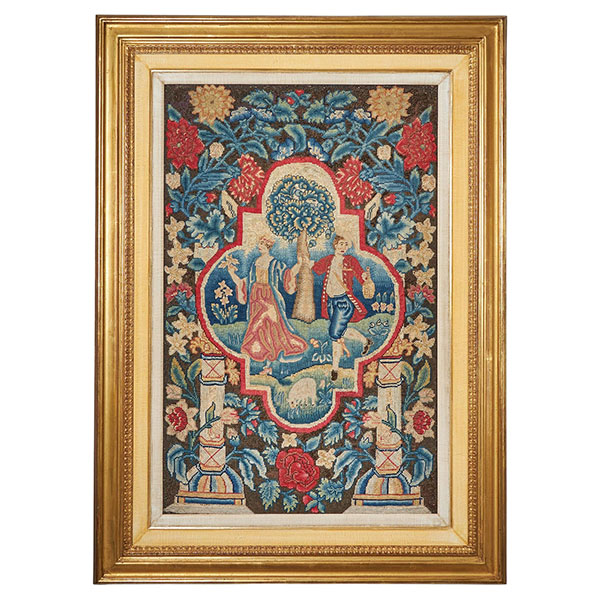
A Rare and Vibrant Framed 18th Century George II Needlework Picture, Circa 1730
A Rare and Vibrant Framed 18th Century George II Needlework Picture, Circa 1730 £16,000Follow UsA Rare and Vibrant Framed 18th Century George II Needlework Picture, Circa 1730 A rare and vibrant early 18th century George II pictorial...
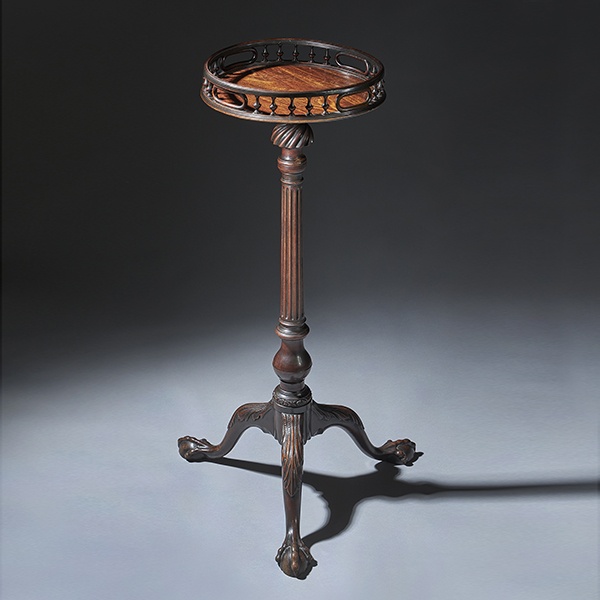
A Fine George II 18Th Century Chippendale Period Carved Mahogany Torchiere. Circa 1755-1765, England
A FINE GEORGE II 18TH CENTURY CHIPPENDALE PERIOD CARVED MAHOGANY TORCHIERE Circa 1755-1765, England £25,000Follow UsA FINE GEORGE II 18TH CENTURY CHIPPENDALE PERIOD CARVED MAHOGANY TORCHIERE, Circa 1755-1765, England An exquisitely fine and...
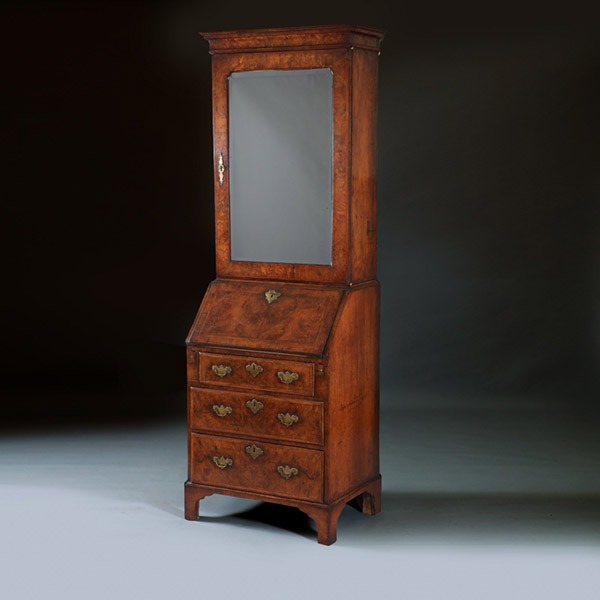
A Fine Early 18th Century George I Burr Walnut Bureau Bookcase, Circa 1715
A Fine Early 18th Century George I Burr Walnut Bureau Bookcase, Circa 1715 £11,500Follow UsA Fine...

18th Century George III Mahogany Tripod Table, Circa 1770
18th Century George III Mahogany Tripod Table, Circa 1770 £2,200Follow Us18th Century George III...

Fine William and Mary 17th Century Olive Oyster Lace Box
Fine William and Mary 17th Century Olive Oyster Lace Box £2,600Follow UsFine William and Mary 17th...

A Fine and Rare George III Octagonal Figured Satinwood Box, C.1790
A Fine and Rare George III Octagonal Figured Satinwood Box, C.1790 £2,200Follow UsA Fine and Rare...

A Rare and Vibrant Framed 18th Century George II Needlework Picture, Circa 1730
A Rare and Vibrant Framed 18th Century George II Needlework Picture, Circa 1730 £16,000Follow UsA Rare and Vibrant Framed 18th Century George II Needlework Picture, Circa 1730 A rare and vibrant early 18th century George II pictorial...

A Fine George II 18Th Century Chippendale Period Carved Mahogany Torchiere. Circa 1755-1765, England
A FINE GEORGE II 18TH CENTURY CHIPPENDALE PERIOD CARVED MAHOGANY TORCHIERE Circa 1755-1765, England £25,000Follow UsA FINE GEORGE II 18TH CENTURY CHIPPENDALE PERIOD CARVED MAHOGANY TORCHIERE, Circa 1755-1765, England An exquisitely fine and...

A Fine Early 18th Century George I Burr Walnut Bureau Bookcase, Circa 1715
A Fine Early 18th Century George I Burr Walnut Bureau Bookcase, Circa 1715 £11,500Follow UsA Fine...
